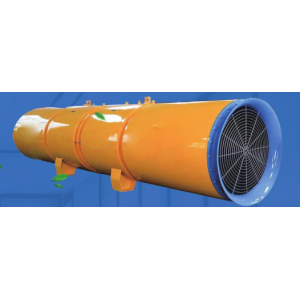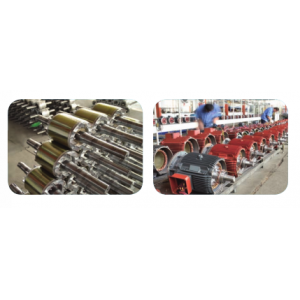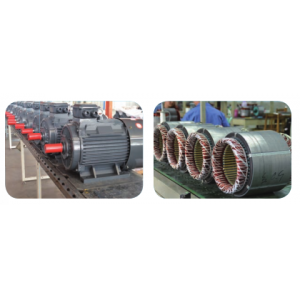Control of fresh air units
1. Getting air temperature control
The air supply temperature control is the specified air temperature control. The applicable conditions are usually the fresh air unit to meet the indoor sanitation requirements rather than the load of the indoor load.Therefore, throughout the control time, the air supply temperature is based on the principle of maintaining a constant value.Due to the different requirements for indoor in winter and summer, the temperature of winter and summer air supply should have different requirements.In other words, when the fresh air unit sets the air supply temperature control, there are two control values ??in the year -winter control value and summer control value. Therefore, the problem of conversion of the controller winter and summer conditions must be considered.
When the air supply temperature control is controlled, the water volume controls the water in summer, the amount of water volume of the heat disk tube or the steam disk pipe in winter.In order to manage convenience, the temperature sensor is generally located on the air supply pipe in the machine room where the unit is located.
2. Interior temperature control
For some DC systems, fresh air can not only meet the environmental standards, but also bear all indoor loads.Because indoor load changes, at this time, the method of controlling the air supply temperature must not meet indoor requirements (may be overheated or too cold).Therefore, the temperature of the location must be controlled.It can be seen that at this time, the temperature sensor must be set in the typical area of ??the controlled room.Because the DC system is usually equipped with an exhaust system, the temperature sensor is located in the exhaust pipeline and considering a certain correction is also a feasible method.
In addition to the DC system, the fresh air unit is usually used with the fan coil.In some projects, due to various reasons (such as restrictions on dehumidification capacity of the fan coil, etc.), the fresh air unit assumes part of the indoor load during design. This approach does not exist according to the air supply temperature control for the air supply temperature control.questionable.However, when the outdoor climate changes make the indoor heat balance (such as some time of the transition season), if the air supply temperature continues to control the air supply temperature, it will inevitably cause the room to be too cold (when the cold water is provided) or the heat is overheated (when the heating water supply)At this time, indoor temperature control should be used.Therefore, in this case, in terms of operation throughout the year, a joint control method of air supply temperature and indoor temperature should be adopted.
3. Relative humidity control
The main point of the relative humidity control of the fresh air unit is to choose the setting location or control parameter of the humidity sensor, which is related to its humidified source and control method.
(1) Steam humidify
For places with high requirements, the steam humidification should be automatically adjusted according to the requirements of the humidity control.This method requires the steam humidifier to use the adjustment valve (linear characteristics), and the regulator shall use a PI controller.Due to the good stability of this method, the humidity sensor can be set on the air supply pipeline in the computer room.
For high -level civil buildings required, it can also be used in control.In this way, it can be used with a bit -type humidifier (with fast -opening valve) and a bit type regulator, which is beneficial to reduce investment.
When using dual -position control, because the bit humidifier only has the function of the full level, if the humidity sensor is still located on the air supply pipe, once the humidifier is fully opened, the sensor will immediately detect that the humidity is higher than the set value and requires that the value is required to be required.The decentralized valve (because the larger humidifier that is usually selected must be higher than the design requirements); once it is closed, the sensor will immediately detect that the humidity is lower than the set value and requires opening the humidifier, which will inevitably cause the humidifier to cause the humidifierThe oscillation of the valve runs, the action is frequent, and the service life is shortened.Obviously, this phenomenon is caused by the small wet capacity from the humidifier to the air duct.Therefore, when the steam humidifier is controlled, the humidity sensor should be located in a typical room (area) or a relatively gentle position with a relatively gentle humidity change to increase the humidity capacity and prevent the humidifier valve switch from being too frequent and damaged.
(2) High -voltage spray, ultrasonic humidity and electricity humidification
These three are all type of humidification.Therefore, its control means and the setting of the sensor should be similar to the condition of controlling steam humidification by bit formula.That is, the controller adopts a bit formula to control the mounting (or switch) of the humidifier, and the humidity sensor should be located in the typical room area.
(3) Circular water spraying and humidification
Circular water spray humidification is different from the processing process of high -pressure spray humidification.In theory, the former belongs to the wetness and the latter belongs to no dew point humidification.If the bit controller is used to control the water spray pump, the setting principle is similar to the high -pressure spray condition.However, in some projects, the water spray pump itself does not control it, but just locks and stop with the air -conditioning unit. In order to control the amount of humidification, the preheating coil can be set in front of the humidifier to control the heating volume of the preheating coil tube., Ensure that the "machine dew point" TL after the humidifier (the point of the point of the DN line is the intersection of the DN line and the φ = 80%to 85%) to achieve the purpose of controlling the relative humidity.
(4) Carbon dioxide (CO2) concentration control
Generally, the larger air volume of the fresh air unit is designed in accordance with the hygiene requirements (except the DC crew considering indoor load).In the actual use process, the number of people in the room is not always full. When the number of personnel is not large, the new air volume can be reduced to save energy. This method is particularly suitable for some office buildings with a new air and wind -winding unit pipe system.Small conference rooms and other places used.
In order to ensure the basic indoor air quality, the method of measuring indoor CO2 concentration is usually measured.Each room has a CO2 concentration controller to control the opening of the electric wind valve on its fresh air support. At the same time, in order to prevent the static pressure in the system, the static pressure controller control the fan speed on the total air supply pipe.Therefore, this will not only reduce the new air -cooled load, but also the fan consumption will also decrease.
Obviously, this control belongs to the variable air volume control (for the details of the variable air volume control), and the application of this control method is not much. One important reason is that the CO2 concentration controller products are not popular (only a few manufacturers are produced),At the same time, this control method is large, and its comprehensive economic benefits need to be analyzed in detail.
(5) Anti -frozen and locks
In areas in the winter outdoor design temperature below 0 ° C, the anti -freezing problem of the tray should be considered.In addition to the prevention measures that should be adopted in the design of the air -conditioning system, a certain means should also be adopted from the aspect of the unit electrical and control.
1) Limit the minimum opening of the electric valve of the heat disk tube
In the case of the selection of the tray that meets certain requirements, the minimum opening of the electric tube electric valve can be limited.In particular, the two -control system in the two control systems is even more so. After the minimum openness is set, it should be able to ensure the minimum water in the dish.
2) Set anti -freezing temperature control
This is another measure to prevent frozen tubes during operation.A temperature sensor (controller) can be set at the water inlet (or on the water back of the water) in the water disk tube to measure the temperature of the water back.When the measured value is low to about 5 ° C, the antifreeze controller moves, stops the operation of the air -conditioning unit, while opening a hot water valve.
3) Unlock new wind valve
In order to prevent the cold wind from excessive penetration caused by frozen tubes, the new wind valve should be closed when the unit operates.When the unit starts, open the new wind valve (usually open the wind valve, then open the air venture, and prevent the wind valve from being too large).Regardless of whether the new wind valve is turned on or closed, the aforementioned anti -freezing controller has always worked normally.
Except for the wind, electric water valves, humidifiers and water spray pumps should be electrical and fans.When running in winter, hot water valves should be opened in the start of the equipment in all crews.
 Pipe connection method of air
Pipe connection method of air
 Installation and debugging of
Installation and debugging of
 Advantages and adjustment meth
Advantages and adjustment meth
 How to debug a centrifugal cur
How to debug a centrifugal cur

